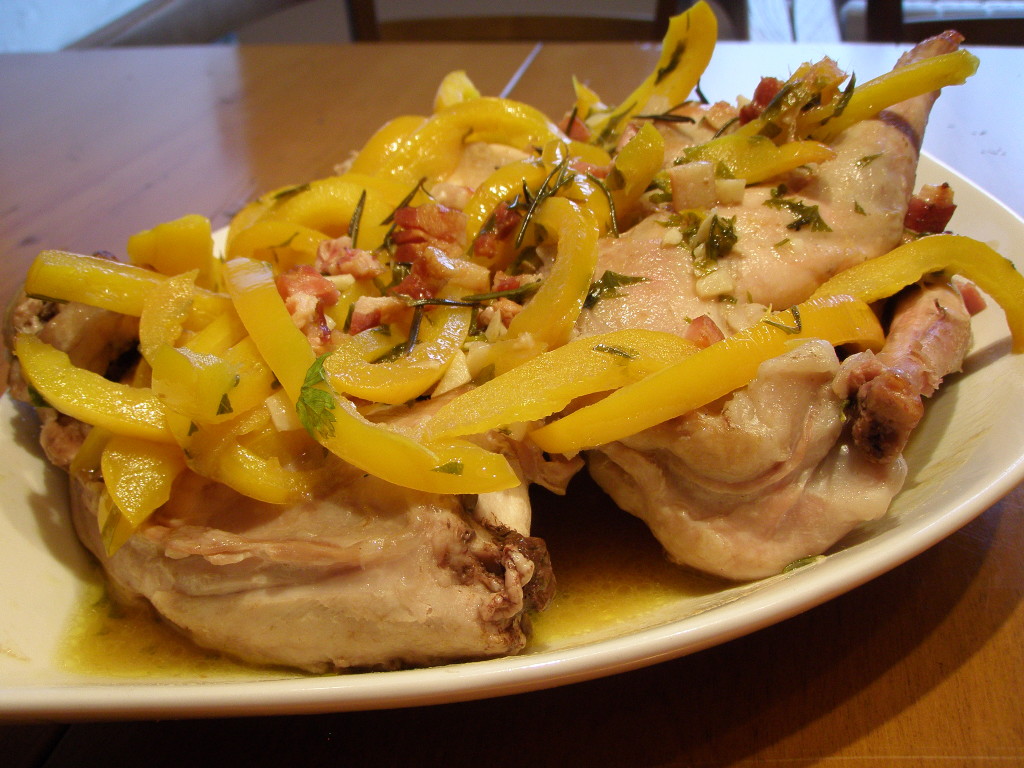On Sunday supplement
Food and Wine
Tastes like chicken. You know that’s not true, everyone says that to try to get you to eat something different in the lighter meat category. I’ve taken to telling people it tastes like cuy, or guinea pig, a delectable treat throughout the lands of our neighbors to the northwest in Peru. It kind of gets the point across. When it comes down to it, rabbit tastes like, well, rabbit.
With spring firmly arrived, rainstorms and all, the annual season of blackouts already beginning (last year our part of Recoleta got to 19 of them, ranging between 2 hours and 3 days, this week we launched in with a 2-1/2 day stretch already), we’re cooking with gas, on the grill, and by flashlight (for lighting purposes, not cooking, a decidedly ineffective method I’m sure). It’s rabbit cooking time.
If you’ve never cooked with rabbit, the thing to know is that it’s really, really lean. It’s probably got a BMI that would make Kate Moss seem rubenesque. As such, you need to consider a couple of things – adding fat to the dish, and cooking time. The latter has to be either very quickly – usually for the rabbit loin section, or long and slow, for the other joints. I generally find that the best bet is a braise or low heat saute that goes long enough to tenderize the meat.
One of my favorite dishes is based on a Piemontese classic – Coniglio Con la Peperonata. For those of you just not up to trying rabbit (but really, give it a try, it’s delicious), this dish can be made with chicken – it won’t be the same, rabbit and chicken really don’t taste alike, though they’re both mild, but it will still be a tasty dish.
Rabbit with Sweet Peppers
1 1-kg rabbit
60 gm smoked bacon, chopped
1 tablespoon fresh rosemary leaves stripped from the stalk
4 tablespoons butter
1 tablespoon olive oil
2 fresh bay leaves
250 ml chicken broth
salt and pepper
Cut the rabbit in serving pieces – usually that means cutting six pieces – cut across the body at the front and back of the loin and rib section, then cut each of the three sections in half down the middle. Saute the bacon and rosemary in a mix of the butter and olive oil, then add the rabbit pieces and cook until browned. Add the bay leaves and stock, salt and pepper to taste, and let simmer over low heat for 35 minutes, turning the pieces occasionally. Move to a serving platter.
While the rabbit is simmering:
3 red or yellow bell peppers or a mix
4 tablespoons butter
1 tablespoon olive oil
3 oil-packed anchovies
2 cloves garlic, chopped
handful of parsley, chopped
4 tablespoons red wine vinegar
salt and pepper
Warm the butter with the anchovies and stir until they dissolve. Add the peppers and raise the heat and cook until they’re starting to get limp. Add the garlic, parsley, and vinegar and cook until the vinegar has just evaporated. Season to taste. Pour over the rabbit pieces.
Now, although there are six serving pieces here, a one kilogram rabbit divided six ways, after factoring out the bones, isn’t a whole lot, so I generally recommend figuring on two pieces per person, though that obviously depends on what else you’re serving for dinner. Or, perhaps a light lunch, where one piece may well be enough.
What to drink with this? In Piemonte we’d be downing a bottle of Barbera or a lighter Nebbiolo with it. Neither is common here – the only Nebbiolo I know of produced in Argentina is the excellent one from Familia Cecchin of Maipú, if you can lay your hands on a bottle. There are a few Barberas around, and several blended with other grapes, a perennial favorite is from Famila Adrover in Lujan de Cuyo. Or, a lighter Bonarda, there are many to choose from.
A series of recipes and articles that I started writing for the Buenos Aires Herald Sunday supplement, Food & Wine section, at the beginning of 2012. My original proposal to them was to take local favorite dishes and classics and lighten them up for modern day sensibilities. We’re not talking spa or diet recipes, but at the very least, making them healthier in content, particularly salt, fat and portion size. As time went by, that morphed into a recipe column that, while emphasizing food that is relatively “good for you”, wasn’t necessarily focused on local cuisine. At the beginning of 2013 I decided to stop writing for them over some administrative issues, but it was fun while it lasted.
